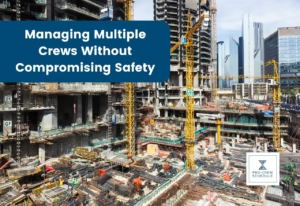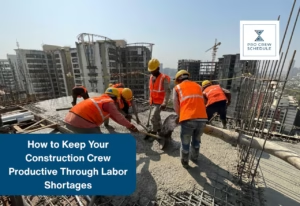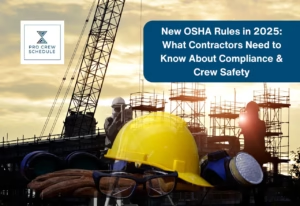Running multiple crews across different job sites is no small task. It’s a daily balancing act. You’ve got timelines to hit, budgets to protect, and clients breathing down your neck for progress updates. At the same time, you can’t lose sight of the one thing that matters most—safety. Because no matter how fast the work moves, or how smooth the schedule looks on paper, one overlooked safety step can turn everything upside down.
Here’s the challenge. The more crews you’ve got moving, the more chances there are for things to slip through the cracks. Communication gaps pop up. Safety checks get missed. Tasks overlap. Suddenly, you’re dealing with confusion, not productivity. And when that happens, risk shoots through the roof.
The truth is, safety and productivity aren’t opposites—they work together. If your crews are safe, they’re steady, consistent, and able to deliver without setbacks. If you cut corners, you might get ahead for a day, but eventually the downtime from accidents, injuries, or stop-work orders will catch you.
That’s why this guide is here. We’re breaking down practical, real-world ways to manage multiple crews without compromising safety. These aren’t just theories. They’re proven strategies we’ve seen across projects, from high-rise jobs downtown to sprawling developments spread across counties. And they’ll help you keep your crews on track, your projects moving, and your sites safe.
Why Safety Becomes Harder With Multiple Crews
Managing one crew is tough enough. Add two, three, or more? Suddenly, the risk multiplies. Why? Because the more moving parts you’ve got, the harder it is to keep them aligned. Think of it like juggling. One ball, easy. Two balls, manageable. Five balls? Drop one, and everything comes crashing down.
Here are a few realities every contractor knows too well:
- Different Supervisors, Different Styles – Every crew leader has their own way of running the team. Some are by-the-book, others lean on experience, and a few take shortcuts. That inconsistency creates safety blind spots.
- Deadline Pressure – With multiple crews, the schedule is tight. Everyone’s rushing. And when people rush, things get missed—like PPE checks, fall protection tie-offs, or hazard scans.
- High-Risk Overlaps – Crews may be working side by side or in sequence. Without tight coordination, one team can end up creating hazards for another. For example, demo dust drifting into an area where another crew is installing electrical.
- Fatigue from Oversight – Supervisors running from site to site can’t see everything. And if leadership isn’t present, crews may skip steps to move faster.
We’ve seen it firsthand. On one project, a crew skipped PPE checks to save ten minutes. Ten minutes. That decision led to a preventable hand injury, an ER visit, and two days of downtime. Multiply that across multiple sites, and you can see why managing crews without tight safety controls becomes a real uphill climb.
Bottom line—when crews multiply, risk multiplies. And unless you’ve got systems to tighten the gaps, the pressure to hit deadlines will always threaten safety.
Common Safety Challenges in Multi-Crew Management
So what are the biggest safety headaches when you’ve got multiple crews running? Let’s lay them out clearly, because once you name the problems, you can start solving them.
- Miscommunication Between Site Managers
- This is the number one culprit. Different sites, different supervisors, different updates. If there’s no central hub for information, things get lost. Crews show up without the right materials. Hazards don’t get flagged in time.
- Inconsistent Training and Enforcement
- One crew might be fully trained on fall protection. Another? Not so much. Without a standard approach, safety varies from site to site. That inconsistency is dangerous.
- Poor Visibility Across Sites
- You can’t be everywhere at once. If you don’t have eyes on each site, things slip. Unsafe scaffolding, missing guardrails, improper lifts—all of it can go unnoticed until it’s too late.
- Crew Fatigue and Over-Scheduling
- When multiple jobs overlap, there’s a temptation to stretch crews thin. Long shifts and back-to-back schedules wear people out. And tired workers make mistakes.
- Weak Documentation and Reporting
- Incident reports, safety checks, near-miss logs—without proper documentation, patterns go unnoticed. A hazard that pops up on one site might be happening elsewhere, but no one connects the dots.
These aren’t just theoretical. They’re the challenges every general contractor or project manager faces once the job scales up. The key is not to ignore them but to plan ahead. Because the difference between a project that runs smooth and one that gets shut down often comes down to how well these issues are managed.
Best Practices for Keeping Safety a Priority
Now for the good part—the fixes. The truth is, managing multiple crews safely isn’t impossible. It just takes discipline, structure, and the right tools. Here’s what works:
Standardize Safety Protocols
Every crew needs to play by the same rules. No exceptions. That means:
- One unified safety program rolled out across all sites.
- Daily toolbox talks to refresh crews before work starts.
- Safety checklists for supervisors, so nothing gets overlooked.
Consistency kills confusion. When every worker knows the expectations, there’s no gray area.
Strengthen Communication Channels
Clear lines of communication prevent most problems. A few ways to do it:
- Use scheduling and crew management software for updates and alerts.
- Define reporting structures. Who answers to who? Make it crystal clear.
- Encourage crews to raise safety concerns immediately without fear of slowing down progress.
Train Continuously
Safety isn’t a one-and-done. It’s ongoing. Build in:
- Regular refresher training for every crew.
- Leadership rotations so supervisors share best practices.
- Scenario-based drills—because practicing for emergencies saves lives when they happen.
Monitor and Audit
You can’t improve what you don’t measure. So:
- Run random inspections across all sites.
- Document incidents, near-misses, and observations.
- Use digital tools for real-time reporting and safety trend analysis.
When you combine these practices, you start building a culture. One where safety isn’t just compliance, it’s second nature.
Using Technology to Oversee Multiple Crews Safely
Here’s where technology steps in. You can’t be at every site, but with the right tools, you don’t have to. Construction management software, like Pro Crew Schedule, makes it possible to manage multiple crews while keeping safety front and center.
How? Let’s break it down:
- Real-Time Tracking – See who’s on-site, what tasks they’re handling, and whether they’re on schedule—all in one dashboard.
- Attendance and Time Logs – Built-in time trackers keep shifts accurate and prevent fatigue from unnoticed overtime.
- Centralized Documentation – Safety checklists, incident reports, training logs—stored digitally, accessible anytime.
- Communication Hub – Messages, alerts, and updates flow through one system, cutting down on confusion.
- Remote Visibility – Instead of hopping from site to site, you can spot problems and fix them from anywhere.
Technology doesn’t replace leadership—it amplifies it. It gives you the oversight you need without burning yourself out running between crews. And that’s the key to scaling safely.
Leadership’s Role in Multi-Crew Safety
Let’s not forget—tools are powerful, but leadership sets the tone. Safety starts at the top. If leaders treat it like a box to check, crews will too. If leaders live it, crews follow.
- Lead by Example – Wear the PPE. Follow the rules. Show crews that safety applies to everyone.
- Empower Supervisors – Give them the authority to stop unsafe work, and back them when they do.
- Build Culture – Celebrate safe crews. Share wins. Make safety part of the job identity, not just a rulebook.
When leadership shows that safety isn’t negotiable, it trickles down. Crews start holding each other accountable. That’s when you know it’s sticking.
Balancing Productivity With Safety
Here’s the big myth: safety slows down productivity. The reality? Unsafe sites are the slowest of all. Accidents, injuries, fines—they bring projects to a halt. Safety keeps things moving.
Take this example. A contractor we worked with had constant delays from minor incidents. Nothing catastrophic, but enough to eat up time. Once they standardized safety checks and used software to track compliance, incidents dropped. Suddenly, crews weren’t losing hours to paperwork, investigations, or medical runs. Their productivity climbed—not despite safety, but because of it.
Think of it this way:
- Cutting Corners = Short-Term Gain, Long-Term Loss
- Proactive Safety = Smooth, Steady Progress
Efficiency comes from planning ahead. And when safety is baked into the plan, you don’t just avoid problems—you create consistency. That’s what clients notice. That’s what builds reputation.
Keep Every Crew on Track—Without the Safety Risks
Managing multiple crews without compromising safety isn’t about luck—it’s about structure, leadership, and the right tools. The risks are real, but so are the solutions. Standardize your protocols. Strengthen your communication. Train continuously. Audit relentlessly. And above all, use technology to give you the visibility you can’t have otherwise.
At Pro Crew Schedule, we’ve built our platform around these very challenges. We know what it’s like to juggle crews, deadlines, and safety demands. That’s why we designed features that put everything—schedules, reports, communication, and compliance—into one place.
If you’re ready to manage multiple crews without the safety headaches, it’s time to see what Pro Crew Schedule can do for your business. Schedule a free demo today!







